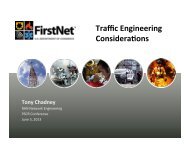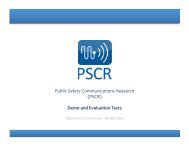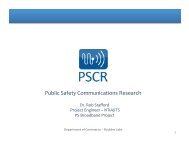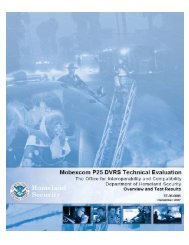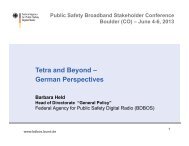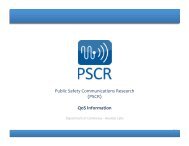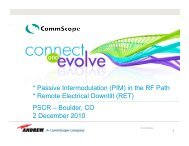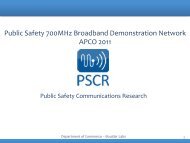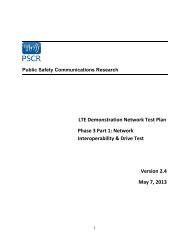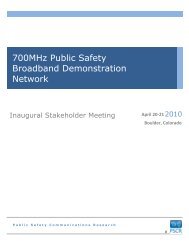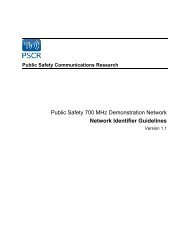Launch Requirements - PSCR
Launch Requirements - PSCR
Launch Requirements - PSCR
Create successful ePaper yourself
Turn your PDF publications into a flip-book with our unique Google optimized e-Paper software.
Introduction<br />
Public Safety Broadband<br />
! User-‐defined fields for activity reporting <br />
! Data sharing policies <br />
1.2.2 Public Safety Grade to be Defined<br />
Various requirements in this document refer to public safety grade (PSG). While the meaning of this <br />
terminology was not defined at the time of this document’s completion, the NPSTC Broadband Working <br />
Group (BBWG) plans to define the terminology as quickly as possible, for use by FirstNet in system <br />
design. For now, the intent of the PSG terminology is to convey the need for design choices that support <br />
a greater overall network reliability and resiliency to network disruptions compared to commercial <br />
networks. The goal is for the NPSBN to be equivalent to public safety land mobile radio (LMR) systems <br />
that support law, fire, and emergency medical service (EMS) operations and are commonly referred to <br />
as “mission-‐critical systems.” <br />
Reliability is achieved in public safety LMR systems through equipment redundancy and minimizing <br />
single points of failures. System operators stock spare parts and, in some cases, transportable backup <br />
systems to restore system failures that do occur. Reliability is achieved through careful system design <br />
and must be considered at the earliest stages of system design. <br />
Resiliency is achieved through careful considerations of local environmental factors and how events <br />
such as earthquakes, wildland fires, hurricanes, floods, lightning, ice, tornadoes, and even vermin can <br />
disrupt or damage the NPSBN network. Consideration to common atmospheric conditions such as <br />
extreme temperature shifts, high/low humidity, or even salty air affects resiliency. One failure common <br />
to all types of natural disasters is the commercial power service. Public safety LMR systems incorporate <br />
both battery and backup generators at the radio sites to insure reliable power for the equipment. The <br />
size and type of batteries and generators vary from region-‐to-‐region depending on a number of factors. <br />
Each disaster type requires different consideration for what is required to ensure network resiliency. <br />
Resiliency is designed into the network starting at the earliest stages of system design. <br />
1.3 Nomenclature for Preliminary High-Level <strong>Launch</strong> <strong>Requirements</strong><br />
<strong>Requirements</strong> in this document are enumerated in tables and informative text is provided outside of the <br />
tables. The next table provides an example. A description of each column follows. <br />
# Requirement<br />
1<br />
2<br />
3<br />
The requirements tables include the following columns: <br />
2 <strong>Launch</strong> Statement of <strong>Requirements</strong><br />
for FirstNet Consideration, December 2012



